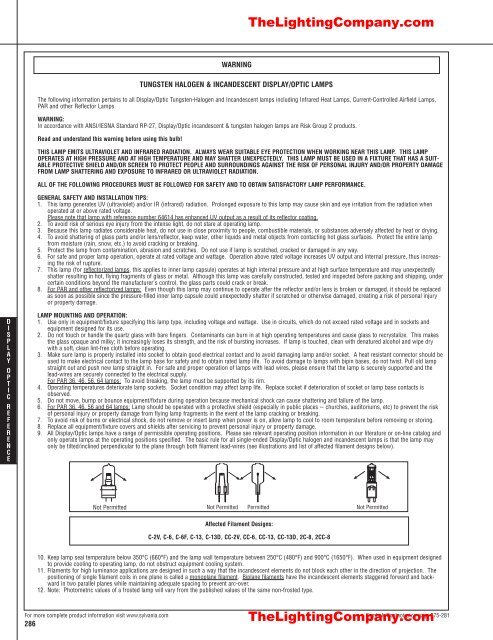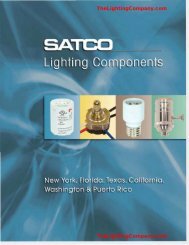Lamp and Ballast Catalog - The Lighting Company
Lamp and Ballast Catalog - The Lighting Company
Lamp and Ballast Catalog - The Lighting Company
- No tags were found...
You also want an ePaper? Increase the reach of your titles
YUMPU automatically turns print PDFs into web optimized ePapers that Google loves.
<strong>The</strong><strong>Lighting</strong><strong>Company</strong>.com<br />
TUNGSTEN HALOGEN & INCANDESCENT DISPLAY/OPTIC LAMPS<br />
<strong>The</strong> following information pertains to all Display/Optic Tungsten-Halogen <strong>and</strong> Inc<strong>and</strong>escent lamps including Infrared Heat <strong>Lamp</strong>s, Current-Controlled Airfield <strong>Lamp</strong>s,<br />
PAR <strong>and</strong> other Reflector <strong>Lamp</strong>s.<br />
WARNING:<br />
In accordance with ANSI/IESNA St<strong>and</strong>ard RP-27, Display/Optic inc<strong>and</strong>escent & tungsten halogen lamps are Risk Group 2 products.<br />
Read <strong>and</strong> underst<strong>and</strong> this warning before using this bulb!<br />
WARNING<br />
THIS LAMP EMITS ULTRAVIOLET AND INFRARED RADIATION. ALWAYS WEAR SUITABLE EYE PROTECTION WHEN WORKING NEAR THIS LAMP. THIS LAMP<br />
OPERATES AT HIGH PRESSURE AND AT HIGH TEMPERATURE AND MAY SHATTER UNEXPECTEDLY. THIS LAMP MUST BE USED IN A FIXTURE THAT HAS A SUIT-<br />
ABLE PROTECTIVE SHIELD AND/OR SCREEN TO PROTECT PEOPLE AND SURROUNDINGS AGAINST THE RISK OF PERSONAL INJURY AND/OR PROPERTY DAMAGE<br />
FROM LAMP SHATTERING AND EXPOSURE TO INFRARED OR ULTRAVIOLET RADIATION.<br />
ALL OF THE FOLLOWING PROCEDURES MUST BE FOLLOWED FOR SAFETY AND TO OBTAIN SATISFACTORY LAMP PERFORMANCE.<br />
GENERAL SAFETY AND INSTALLATION TIPS:<br />
1. This lamp generates UV (ultraviolet) <strong>and</strong>/or IR (infrared) radiation. Prolonged exposure to this lamp may cause skin <strong>and</strong> eye irritation from the radiation when<br />
operated at or above rated voltage.<br />
Please note that lamp with reference number 64614 has enhanced UV output as a result of its reflector coating.<br />
2. To avoid risk of serious eye injury from the intense light, do not stare at operating lamp.<br />
3. Because this lamp radiates considerable heat, do not use in close proximity to people, combustible materials, or substances adversely affected by heat or drying.<br />
4. To avoid shattering of glass parts <strong>and</strong>/or lens/reflector, keep water, other liquids <strong>and</strong> metal objects from contacting hot glass surfaces. Protect the entire lamp<br />
from moisture (rain, snow, etc.) to avoid cracking or breaking.<br />
5. Protect the lamp from contamination, abrasion <strong>and</strong> scratches. Do not use if lamp is scratched, cracked or damaged in any way.<br />
6. For safe <strong>and</strong> proper lamp operation, operate at rated voltage <strong>and</strong> wattage. Operation above rated voltage increases UV output <strong>and</strong> internal pressure, thus increasing<br />
the risk of rupture.<br />
7. This lamp (for reflectorized lamps, this applies to inner lamp capsule) operates at high internal pressure <strong>and</strong> at high surface temperature <strong>and</strong> may unexpectedly<br />
shatter resulting in hot, flying fragments of glass or metal. Although this lamp was carefully constructed, tested <strong>and</strong> inspected before packing <strong>and</strong> shipping, under<br />
certain conditions beyond the manufacturer's control, the glass parts could crack or break.<br />
8. For PAR <strong>and</strong> other reflectorized lamps: Even though this lamp may continue to operate after the reflector <strong>and</strong>/or lens is broken or damaged, it should be replaced<br />
as soon as possible since the pressure-filled inner lamp capsule could unexpectedly shatter if scratched or otherwise damaged, creating a risk of personal injury<br />
or property damage.<br />
LAMP MOUNTING AND OPERATION:<br />
1. Use only in equipment/fixture specifying this lamp type, including voltage <strong>and</strong> wattage. Use in circuits, which do not exceed rated voltage <strong>and</strong> in sockets <strong>and</strong><br />
equipment designed for its use.<br />
2. Do not touch or h<strong>and</strong>le the quartz glass with bare fingers. Contaminants can burn in at high operating temperatures <strong>and</strong> cause glass to recrystalize. This makes<br />
the glass opaque <strong>and</strong> milky; it increasingly loses its strength, <strong>and</strong> the risk of bursting increases. If lamp is touched, clean with denatured alcohol <strong>and</strong> wipe dry<br />
with a soft, clean lint-free cloth before operating.<br />
3. Make sure lamp is properly installed into socket to obtain good electrical contact <strong>and</strong> to avoid damaging lamp <strong>and</strong>/or socket. A heat resistant connector should be<br />
used to make electrical contact to the lamp base for safety <strong>and</strong> to obtain rated lamp life. To avoid damage to lamps with bipin bases, do not twist. Pull old lamp<br />
straight out <strong>and</strong> push new lamp straight in. For safe <strong>and</strong> proper operation of lamps with lead wires, please ensure that the lamp is securely supported <strong>and</strong> the<br />
lead-wires are securely connected to the electrical supply.<br />
For PAR 36, 46, 56, 64 lamps: To avoid breaking, the lamp must be supported by its rim.<br />
4. Operating temperatures deteriorate lamp sockets. Socket condition may affect lamp life. Replace socket if deterioration of socket or lamp base contacts is<br />
observed.<br />
5. Do not move, bump or bounce equipment/fixture during operation because mechanical shock can cause shattering <strong>and</strong> failure of the lamp.<br />
6. For PAR 36, 46, 56 <strong>and</strong> 64 lamps: <strong>Lamp</strong> should be operated with a protective shield (especially in public places -- churches, auditoriums, etc) to prevent the risk<br />
of personal injury or property damage from flying lamp fragments in the event of the lamp cracking or breaking.<br />
7. To avoid risk of burns or electrical shock, do not remove or insert lamp when power is on, allow lamp to cool to room temperature before removing or storing.<br />
8. Replace all equipment/fixture covers <strong>and</strong> shields after servicing to prevent personal injury or property damage.<br />
9. All Display/Optic lamps have a range of permissible operating positions. Please see relevant operating position information in our literature or on-line catalog <strong>and</strong><br />
only operate lamps at the operating positions specified. <strong>The</strong> basic rule for all single-ended Display/Optic halogen <strong>and</strong> inc<strong>and</strong>escent lamps is that the lamp may<br />
only be tilted/inclined perpendicular to the plane through both filament lead-wires (see illustrations <strong>and</strong> list of affected filament designs below).<br />
D<br />
ISPLAY<br />
O<br />
PTIC<br />
R<br />
EFERENCE<br />
For more complete product information visit www.sylvania.com Symbols/Footnotes on page 275-281<br />
Not Permitted<br />
Not Permitted<br />
Permitted<br />
Not Permitted<br />
Affected Filament Designs:<br />
C-2V, C-6, C-6F, C-13, C-13D, CC-2V, CC-6, CC-13, CC-13D, 2C-8, 2CC-8<br />
10. Keep lamp seal temperature below 350°C (660°F) <strong>and</strong> the lamp wall temperature between 250°C (480°F) <strong>and</strong> 900°C (1650°F). When used in equipment designed<br />
to provide cooling to operating lamp, do not obstruct equipment cooling system.<br />
11. Filaments for high luminance applications are designed in such a way that the inc<strong>and</strong>escent elements do not block each other in the direction of projection. <strong>The</strong><br />
positioning of single filament coils in one plane is called a monoplane filament. Biplane filaments have the inc<strong>and</strong>escent elements staggered forward <strong>and</strong> backward<br />
in two parallel planes while maintaining adequate spacing to prevent arc-over.<br />
12. Note: Photometric values of a frosted lamp will vary from the published values of the same non-frosted type.<br />
286<br />
<strong>The</strong><strong>Lighting</strong><strong>Company</strong>.com




